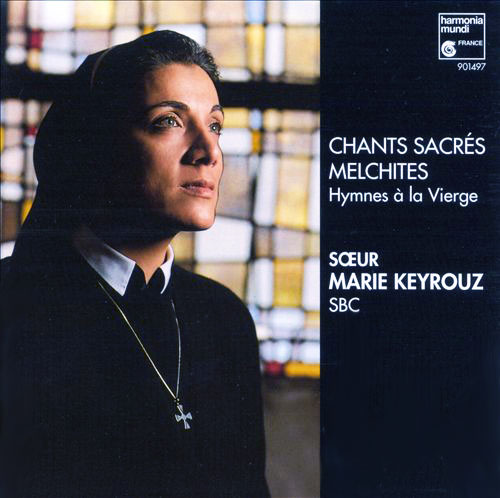 Chant Melkites
Chant Melkites
| 20,00 ą |
-
Axion Esti
01:53
Sister Marie Keyrouz – Axion Esti
-
Ya walidata-l-ilah
01:40
Sister Marie Keyrouz– Ya walidata-l-ilah
-
Adhimi ya nafsi
02:15
Sister Marie Keyrouz – Adhimi ya nafsi
-
Inna-l-baraya
03:01
Sister Marie Keyrouz – Inna-l-baraya
-
Inna-l-alsuna
01:41
Sister Marie Keyrouz – Inna-l-alsuna
-
Ihfadhi uma-l-ilah
01:49
Sister Marie Keyrouz – Ihfadhi uma-l-ilah
-
Istabchir
01:24
Sister Marie Keyrouz – Istabchir
-
Allahu-r-rabu
01:52
Sister Marie Keyrouz – Allahu-r-rabu
-
Inna-l malak
02:40
Sister Marie Keyrouz – Inna-l malak
-
Ifrahi
01:43
Sister Marie Keyrouz – Ifrahi
-
Ayyatuha-s-sayidatu
01:21
Sister Marie Keyrouz – Ayyatuha-s-sayidatu
-
Litataazam
01:48
Sister Marie Keyrouz – Litataazam
-
Jamiou el ajyal
02:34
Sister Marie Keyrouz – Jamiou el ajyal
-
Anti yawalidata-ilah
03:29
Sister Marie Keyrouz – Anti yawalidata-ilah
Chant Melkite
The chant of the melkite Church - the arabic name for the imperial Byzantine Church, derived from the syriac malka , king - belongs to the liturgies of the Near East : it is, therefore, practiced in a region constituting a veritable mosaic of civilizations.
We should remember that this Phonician Greek Church came into existence in a place of intense religious, philosophical, poetic, judicial, grammatic, rhetorical and philological activity where Hebrew, Aramaic, Greek, Latin and Arabic rubbed shoulders even in the streets, and in which the civilisations of Antiquity, both Eastern and western, were still trying to survive, in spite of time, and unknown to men.
These poetic texts, taken from the Canons of the Church Fathers (9th Ode) and dedicated to the Mother of God, are attached in various ways to extremely ancient traditions.
Whether the text is in Greek or in Arabic, we find the micro-intervals characteristic of antique musical theories, which would have been translated into Syriac, then from Syriac into Arabic, or directly from Greek into Arabic. We observe, too, the Pythagorean diatonism clearly described in the second century by Nicomachus of Gerasa and Theon of Smyrna.
the sound is never rigidly set; like a cell,As if sister Marie Keyrouz were following the treatise of Porphirius of Tyre (Bar Malkan, 3rd cent.), it expands, contracts, varies in color.
One would note speak of a numerical division of the tone or semitone, but rather of a vibration, a natural palpitation of the sound, prompted by the phonation. Codified both in theory and in practice, this constitutes a chant that is charged with emotion reaching from humility to jubilation - when rapture surpasses the conscious, stretching out for the ultimate Beauty of the Logos of the Gospel of Saint John.
Similary, in chants Nos.3, 9 and 13 the I mode proclaims the joy of the Nativity and Resurection of Christ, and of the Assumption of the blessed Virgin.
In these great liturgical moments the richness of the modulations makes the chant a veritable commentary, a personal and free exegesis of a text that is received to be transmitted instantaneously.
From then on, whether the chant is improvised or not, it becomes a re-creation, a reinvention.
Sister Marie Keyrouz